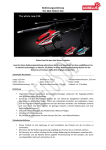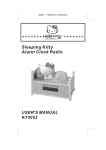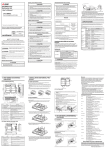Download USER'S MANUAL - TC Electronic
Transcript
USER’S MANUAL Important Safety Instructions 1 2 3 4 5 6 7 Read these instructions. Keep these instructions. Heed all warnings. Follow all instructions. Do not use this apparatus near water. Clean only with dry cloth. Do not block any ventilation openings. Install in accordance with the manufacturer’s instructions. 8 Do not install near heat sources such as radiators, heat registers, stoves, or other apparatus (including amplifiers) that produce heat. 9 Only use attachments/accessories specified by the manufacturer. 10Refer all servicing to qualified service personnel. Servicing is required when the apparatus has been damaged in any way, such as power-supply cord or plug is damaged, liquid has been spilled or objects have fallen into the apparatus, the apparatus has been exposed to rain or moisture, does not operate normally, or has been dropped. Warning! • To reduce the risk of fire or electrical shock, do not expose this equipment to dripping or splashing and ensure that no objects filled with liquids, such as vases, are placed on the equipment. • Do not install in a confined space. Service • All service must be performed by qualified personnel. Caution: You are cautioned that any change or modifications not expressly approved in this manual could void your authority to operate this equipment. When replacing the battery follow the instructions on battery handling in this manual carefully. EMC/EMI This equipment has been tested and found to comply with the limits for a Class B Digital device, pursuant to part 15 of the FCC rules. 2 These limits are designed to provide reasonable protection against harmful interference in residential installations. This equipment generates, uses and can radiate radio frequency energy and – if not installed and used in accordance with the instructions – may cause harmful interference to radio communications. However, there is no guarantee that interference will not occur in a particular installation. If this equipment does cause harmful interference to radio or television reception – which can be determined by turning the equipment off and on –, the user is encouraged to try correcting the interference by one or more of the following measures: • • • • Reorient or relocate the receiving antenna. Increase the separation between the equipment and the receiver. Connect the equipment to an outlet on a circuit different from the one to which the receiver is connected. Consult the dealer or an experienced radio/TV technician for help. For the customers in Canada: This Class B digital apparatus complies with Canadian ICES-003. Cet appareil numérique de la classe B est conforme à la norme NMB-003 du Canada. 3 BOLD AS JIMI (TAPE) WARM TAPE (TAPE) 4 SUMMERS TIME (FLANGER) UNCHAIN MY FLANGE (FLANGER) 5 (EN) Introduction Congratulations! You have just bought a flanger pedal that is a steppingstone to a world of inspiration, innovation and tone. We are proud to present Vortex Flanger, providing awesome flanger sounds, intuitive controls and instant satisfaction. With Vortex Flanger you are set for any situation that calls for some serious flanging, from subtle two-tape-machines-simultaneously to full-on 747-take-off sounds. But that’s not all! We love tone as much as any guitarist out there, so we are very excited to present a brand new, groundbreaking concept: TonePrint! TonePrint gives instant access to custom-tweaked sounds. We have gathered an impressive list of guitar heroes and had them tailor their signature sounds – the tones that made them famous. Toneprint will not just bring you close to the sounds of your idols, they give you their actual sounds! Using TonePrints is both easy and fun. Just download the TonePrint you want from www.tcelectronic.com and, voila, your favorite artist has just put his TonePrint in your pedal. Forget emulation – let’s talk collaboration! www.tcelectronic.com - www.youtube.com/tcelectronic 6 1 - Effect on/off (true bypass) 2 - 1/4 inch mono jack input 3 - 1/4 inch mono jack input (for stereo in) 4 - 1/4 inch mono jack output 5 - 1/4 inch mono jack output (for stereo out) 6 - Feedback control 7 - Speed control 8 - Flange/TonePrint/Tape selector 9 - Depth control 10 -Delay time control 11 -Power in (9VDC) 12 -USB connection for exchanging TonePrint settings and software updates. 7 Connecting Input jacks - Use MONO for mono input and both MONO and STEREO if connecting a stereo source. If you run on battery we recommend removing the mono input jack to preserve battery power when you don’t play. Output jacks - connect to another pedal or directly into an amp or mixer. Use MONO for mono setups and both MONO and STEREO for stereo setups. Notice that it is possible to select between true bypass and buffered bypass mode via a dip switch located under the battery cover. Power in - use a 9 VDC power supply with the following symbol: USB Connect to a computer using the supplied USB cable for upload of TonePrint settings. The connector-type is Mini-B. 8 The controls FEEDBACK Use the FEEDBACK knob to control the amount of feedback of the short modulated delay that causes the Flanging effect. Turn the knob counter-clockwise to get negative feedback and clockwise to get positive feedback. Where the positive range gives a traditional studio-type feedback the negative range gives more extreme and “tube-like” sound. Try them out! 12 o’clock position is neutral = no feedback. Notice that too high settings might introduce internal feedback, resulting in a squealing noise that in most cases is unwanted in flanging effects. SPEED Use the SPEED knob to set the speed of the effect. DEPTH Use the DEPTH knob to set the intensity of the effect. The more you turn the knob clock-wise, the more “out of tune” the modulated part of the signal is. DELAY TIME Typical delay values for flanging effects are around 1-2 ms whereas Chorus effects occur with delay times around 10 ms. Short delay times give very intense, “jet engine”-type sounds with plenty high-end frequencies. Longer delay times give the slightly darker more “tube”-type sounds. 9 FLANGER TYPE Selector: Switch between standard Flange, Tape type and TonePrint FLANGE The characteristic “flanging” sound occurs when a pitch-modulated part of the signal is slightly delayed and fed back to the input of the effect algorithm. Experiment with the Feedback parameter to get an idea of the effects you can achieve. TAPE - also know as the “through-zero-flange” emulates the original way of creating a flange effect, with two identical pieces of audio material being played back simultaneously on two tape decks and then being mixed on a third deck. The flanging effect was achieved by slowing down and speeding up the two decks at different times. An essential part of the special effect created this way is the unique phase cancellation occurring when the two signals pass each other in time (the zero point). 10 TonePrint Consider the knobs and switches on your pedal as a few handles that actually controls a large number of parameters. TC Electronic staff has defined the controls, - but wouldn’t it just be cool to let the world’s leading guitar players contribute with their own definition of how the controls should work? YES - this is TonePrint. We allow top guitar players to dig out the pedals hidden tonal potential, re-define the controls and make their own TonePrints. These TonePrints are available for you and uploading TonePrints to your pedal is easy. • • • Connect the pedal to your Mac or PC computer using the supplied USB cable. Find your pedal at www.tcelectronic.com/pedals and download the TonePrint setting from your favorite guitar player to a location where you can easily locate it again. E.g. on your desktop. Open the application and press UPDATE. Now, – once you have selected TonePrint, all controls react exactly as defined by the artist that has provided the TonePrint. 11 Bypass modes and Kill-Dry on/off Unscrew the back-plate and look for the two small dip-switches in the upper left corner. The upper dip-switch (closest to the DC 9V in connection), switches between True Bypass mode (default) and Buffered Bypass mode. True Bypass Buffered Bypass Kill-Dry - off Kill-Dry - on True Bypass – is a hardwire bypass that gives absolutely no coloration of tone when the pedal is bypassed. Using True Bypass on all pedals is a perfect choice in setups with a few pedals and relatively short cables before and after the pedals. Buffered Bypass – If you use a long cable between your guitar and the first pedal, if you use many pedals on your board and if you use a long cable from your board to the amp, then the best solution 12 will most likely be to activate the buffer in the first and last pedal in the signal chain. Can you hear the difference between a pedal in True Bypass or Buffered Bypass? Maybe, maybe not, – many factors apply. Active/passive pick-ups, single coil/humbucker, cable quality, amp impedance and more. We cannot give a single ultimate answer. Use your ears and find the best solution for your setup! Kill-Dry on/off – With Buffered Bypass activated (upper switch to the right), the lower dip-switch sets Kill-Dry on/off. Kill-Dry removes all direct signal from the pedals output and is the mode to use when the pedal is placed in a parallel effects loop. Kill-Dry is NOT an option in True Bypass mode. Changing battery - Unscrew the thumb-screw on the back of the pedal and detach the back-plate. Un-mount the old battery and attach the new battery to the battery clip making sure the polarity is correct. Then remount the back-plate. To save battery life; remove the input jack when you don’t play. Batteries must never be heated, taken apart or thrown into fire or water. Only rechargeable batteries can be recharged. Remove the battery when the pedal is unused for a longer period of time. Dispose batteries according to local laws and regulations. 13 Sounds 2 amazing flanger effects: A 1:1 recreation of the legendary TC Electronic Chorus/Flanger pedal and a classic tape flanger for those psychedelic studio-style flange effects Unique, new TonePrint setting for stuffing Corona Chorus with your favorite artist’s tones Size & Weight 72 mm x 122 mm x 50 mm - 300 g (excl. battery) Battery Dual Supply Rails technology ensures headroom for line level effect loops from a single 9V battery. Battery failure circuit automatically puts Vortex Flanger into true bypass mode if the battery runs out Design Custom ‘hammerhead’ rugged, die-cast aluminum casing built for a life on the road Unique one-screw battery access for lightning fast battery changes Connectors & Inputs/Outputs Stereo inputs with automatic mono/stereo sensing – feed it any signal Stereo outputs for that ultra-wide flanger sound Mini USB connector for uploading custom TonePrints and software updates Knobs etc. Speed, Depth, Feedback and Delay Time knobs with high-quality, metal-shaft potentiometers Heavy duty tactile footswitch with true bypass for zero tone coloration In the box USB cable for uploading TonePrints, Owner’s Manual, TC Electronic Guitar Pamphlet, TC Electronic Sticke. These specifications are subject to change without notice (EN) Technical Specifications 14 TC Electronic, Sindalsvej 34, DK-8240 Risskov [email protected]























